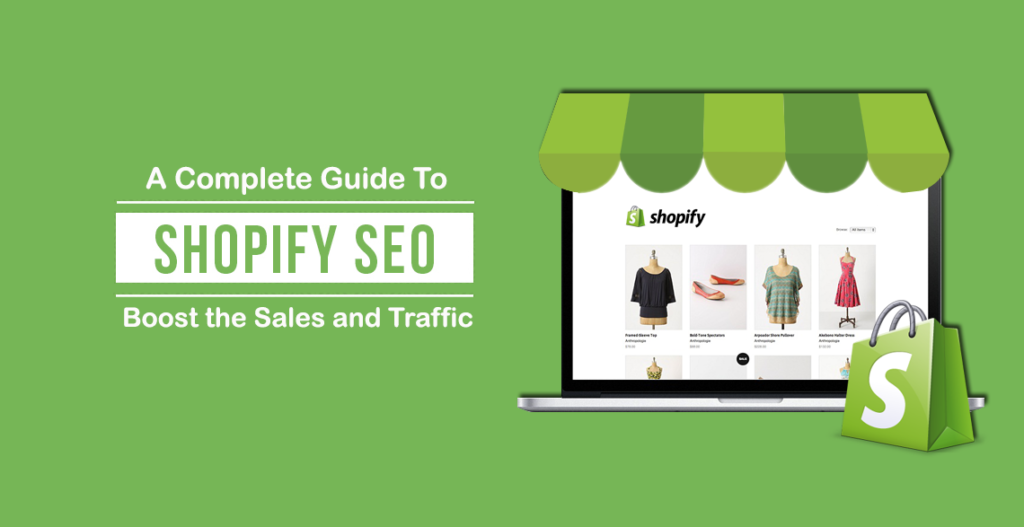Shopify SEO
In the competitive world of e-commerce, having a visually appealing and user-friendly website is just the beginning. To truly succeed in the online marketplace, your Shopify store needs to be optimized for search engines to ensure maximum visibility. One critical aspect of this optimization process is ensuring that your product pages are finely tuned for SEO. In this comprehensive guide, we’ll delve into the strategies and best practices to optimize your Shopify product pages, ultimately improving your search engine rankings and driving more organic traffic to your online store. Shopify SEO.

Why Product Page Optimization Matters
Before we jump into the nitty-gritty details, let’s understand why optimizing product pages is crucial for your Shopify store’s overall SEO strategy.
1. Enhanced Visibility:
- Well-optimized product pages increase the likelihood of your products appearing in search engine results when potential customers are looking for similar items.
- Higher visibility means more opportunities for potential customers to discover and explore your products.
2. Improved User Experience:
- SEO optimization often goes hand-in-hand with enhancing the user experience. When visitors find what they’re looking for quickly and easily, they are more likely to make a purchase.
- A positive user experience also contributes to lower bounce rates and longer on-site engagement, both of which are factors considered by search engines.
3. Increased Conversions:
- Optimized product pages not only attract more visitors but also help in converting those visitors into customers.
- Clear and persuasive product information, accompanied by trust signals like reviews and ratings, can significantly impact a visitor’s decision to make a purchase.
Now, let’s dive into the actionable steps to optimize your Shopify product pages for SEO success.
1. Conduct Thorough Keyword Research
Before you start optimizing your product pages, you need to understand the keywords your potential customers are using to search for products similar to yours. Utilize keyword research tools to identify relevant, high-volume keywords. Incorporate these keywords naturally into your product titles, descriptions, and meta tags.
2. Craft Compelling Product Descriptions
Your product descriptions play a crucial role in both informing potential customers about your products and improving your search engine rankings. Follow these guidelines when creating product descriptions:
- Be detailed and unique: Avoid using manufacturer-provided content and create original, detailed descriptions that highlight the key features and benefits of your products.
- Incorporate keywords naturally: Sprinkle your target keywords throughout the description to signal to search engines that your product is relevant to those queries.
- Use bullet points: Break down information into easily digestible bullet points for better readability.
3. Optimize Product Images
Visual appeal is a key factor in online shopping, and optimized images can contribute to a better user experience. Follow these image optimization tips:
- Use high-quality images: Clear, high-resolution images showcase your products in the best light.
- Compress images: Compressed images improve page load times, contributing to a positive user experience and better SEO rankings.
- Add alt text: Describe your images using descriptive alt text to improve accessibility and provide additional context for search engines.
4. Utilize Unique and Descriptive Meta Tags
Meta tags, including title tags and meta descriptions, are crucial for both user experience and search engine optimization. Each product page should have:
- A unique and compelling title tag: Incorporate your primary keyword and create a title that encourages clicks.
- A concise and informative meta description: Craft a meta description that summarizes the product’s key features and benefits while enticing users to click through.
5. Implement Schema Markup
Schema markup provides additional context to search engines, helping them better understand the content on your product pages. Take advantage of schema markup to enhance your product listings:
- Use product schema: Markup your product pages with product schema to provide detailed information about your products, such as price, availability, and reviews.
- Leverage review schema: Encourage customers to leave reviews, and use review schema to display star ratings in search results, making your listings more appealing.
6. Prioritize Mobile Responsiveness
With a growing number of users accessing websites from mobile devices, it’s crucial that your Shopify store is optimized for mobile. Google considers mobile-friendliness as a ranking factor, so ensure that your product pages are responsive and provide a seamless experience across devices.
7. Encourage Customer Reviews and Ratings
User-generated content, such as customer reviews and ratings, not only builds trust but also contributes to SEO. Positive reviews can influence potential customers, and search engines often reward pages with quality user-generated content.
- Implement a review system: Encourage customers to leave reviews by implementing a user-friendly review system on your product pages.
- Respond to reviews: Engage with your customers by responding to reviews, demonstrating your commitment to customer satisfaction.
8. Optimize Page Load Speed
Page load speed is a critical factor for both user experience and SEO. Slow-loading pages can lead to higher bounce rates and lower search engine rankings. Use tools like Google PageSpeed Insights to identify and address issues affecting your page load speed.
9. Implement Internal Linking
Create a logical and hierarchical structure within your Shopify store by incorporating internal links. Internal linking helps distribute page authority throughout your site, improves navigation, and encourages visitors to explore more of your products.
10. Monitor and Analyze Performance
Regularly monitor the performance of your product pages using analytics tools like Google Analytics and Shopify’s built-in analytics. Track key metrics such as organic traffic, conversion rates, and bounce rates to identify areas for improvement.

Conclusion
Optimizing your Shopify product pages for SEO involves a combination of technical and creative strategies. By implementing the above recommendations, you can enhance the visibility of your products, provide a better user experience, and ultimately drive more organic traffic and conversions to your online store. Stay proactive, regularly update your content, and adapt to evolving SEO trends to maintain a competitive edge in the dynamic world of e-commerce.


